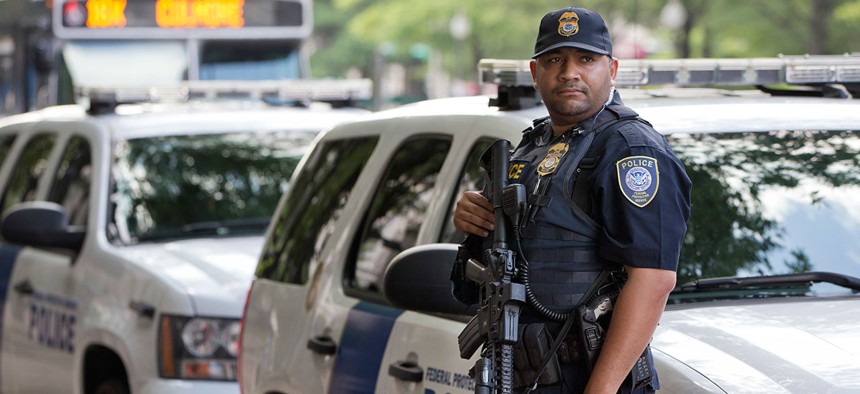
Jacquelyn Martin/AP
America Cannot Stop Every Terror Attack
The U.S. government has spent a lot of money on national security since 9/11. It could use those funds in better ways to improve and save lives.
When an infinite number of bureaucrats are typing an infinite number of memoranda, the country will inevitably wind up with at least one report that correctly predicted any terror attack. (Also, we’ll probably get a copy of Hamlet.)
Of course on September 10, 2001, there was a memo in a Federal Aviation Administration security official’s inbox suggesting that the U.S. dramatically expand its Do Not Fly list. Of course there was a special commission that had been recommending for years the creation of a single coordinated department to fend off terrorist attacks. Of course Orlando shooter Omar Mateen had been questioned under suspicion of terrorist ties before he massacred people in a nightclub.
But the mere existence of those reports—the unconnected dots critics and conspiracy theorists lovingly accumulate and hoard in hindsight—isn’t prophylactic. If everyone says something every single time they see something, the data quickly coalesce into white noise. If any person with a moderately interesting tidbit or clever analysis gets her report shunted up theC.Y.A. chain, the country would see very nearly the same homeland-security outcomes as if no reports had been written at all—only at a much, much higher price.
Government action driven by a desire to “do something, anything, about the threat,” as Steven Brill writes in his September cover story for The Atlantic, is expensive, and frequently counterproductive. In the push to ramp up the homeland-security apparatus, America lost sight of the fact that all money is fungible and all policies have tradeoffs. And now inertia has taken over, with a swarm of bureaucrats, contractors, and grant recipients available to administer a nudge whenever the flow of money seems likely to slow.
Virtually all of national-security spending is one massive, overly complicated trolley problem, the brain teaser that ethicists love to talk about when they get drunk together: People will die no matter what the government does. So how should policymakers best weigh action versus inaction?
Brill writes that “it is astonishing that so many hospitals have refused to spend … the $300,000 to $400,000 necessary per site to increase security” plus another “$250,000 to replace a cesium-chloride blood irradiator with an equivalent FDA-approved nonradiological device.” But is it astonishing, really? This looks like a near-textbook case for cost-benefit analysis. Hospitals have a choice: They can spend $300,000 to improve patient care by buying a new MRI machine or paying nurses more, for instance. Or they can hedge against a very unlikely event—the theft of radioactive materials from their facility—in an officially proscribed way that may or may not be suitable for their work.
The right choice depends in large part on each organization’s ability to estimate the likelihood of a wildly unlikely event, never an easy task. But it could very well be true that not taking extra security measures is the way to maximize life-saving outcomes for the most people. It might not be the right call to skip the security spending, but it’s not “astonishing” that some might refuse to do so in favor of other live-saving improvements—or profits.
After 9/11, no one wanted to hear that millions of small knives have safely been carried on airplanes for decades and the prohibition on them now is unlikely to reduce the risk of being on a hijacked plane going forward. Even if TSA security procedures have reduced this kind of risk somewhat, they have almost certainly not be worth the inconvenience and annoyance and lost productivity that has been caused by the process of taking those knives from law-abiding citizens day after day, year after year. So policymaking and spending marched on as lawmakers studiously ignored the tradeoffs.
As Brill reports, in 2013, the Obama administration quietly changed the guidelines for how to react to a dirty bomb in D.C. with little press or public announcement. But he wasn’t neglecting “what could have been an ambitious, gutsy exercise in public education,” as Brill says. He was simply acknowledging the reality that people are not keen to hear that preventing 50 cancer deaths isn’t worth evacuating a major city under emergency conditions. People don’t like that kind of math when it’s a question of life and death. Opportunity cost is a concept that most politicians are smart enough to understand. (They are also smart enough to know that it’s not an easy sell to the general public.)
Not everything can be a top priority all the time. Terrorists might “take advantage of our failure to make biodefense a top national priority,” as in the fever dreams of last year’s Blue Ribbon Study Panel on Biodefense report from Scooter Libby, Tom Ridge, and co. But if the U.S. were to put an excessive focus on bioterror to the exclusion of airline security, terrorists could take advantage of that as well.
“This is not your father’s terrorism,” said NYPD deputy commissioner for intelligence and counterterrorism John Miller about the new generation of “lone wolves.” Premature 9/11 nostalgia, it appears, is already upon us—a longing for a simpler time when X-raying everyone’s suitcase seemed like a plausible solution to the terrorist threat. Brill’s essay is a well-researched testament to the enduring appeal of fighting the last war. America is hustling to seal off all the places mice might be coming into the house, while ignoring the cockroaches, the suspicious sound that might be termites, and that wasps’ nest that has been out on the back porch for a while.
Brill is right when he says there will be another attack. And the memo predicting that attack has already been written.






